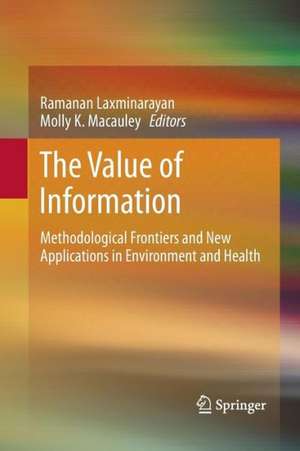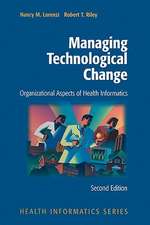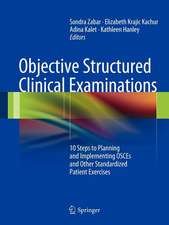The Value of Information: Methodological Frontiers and New Applications in Environment and Health
Editat de Ramanan Laxminarayan, Molly K. Macauleyen Limba Engleză Paperback – 21 sep 2014
| Toate formatele și edițiile | Preț | Express |
|---|---|---|
| Paperback (1) | 693.03 lei 6-8 săpt. | |
| SPRINGER NETHERLANDS – 21 sep 2014 | 693.03 lei 6-8 săpt. | |
| Hardback (1) | 653.98 lei 6-8 săpt. | |
| SPRINGER NETHERLANDS – 10 aug 2012 | 653.98 lei 6-8 săpt. |
Preț: 693.03 lei
Preț vechi: 815.34 lei
-15% Nou
Puncte Express: 1040
Preț estimativ în valută:
132.62€ • 141.81$ • 110.57£
132.62€ • 141.81$ • 110.57£
Carte tipărită la comandă
Livrare economică 18 aprilie-02 mai
Preluare comenzi: 021 569.72.76
Specificații
ISBN-13: 9789400798083
ISBN-10: 9400798083
Pagini: 332
Ilustrații: XXVIII, 304 p.
Dimensiuni: 155 x 235 x 17 mm
Greutate: 0.47 kg
Ediția:2012
Editura: SPRINGER NETHERLANDS
Colecția Springer
Locul publicării:Dordrecht, Netherlands
ISBN-10: 9400798083
Pagini: 332
Ilustrații: XXVIII, 304 p.
Dimensiuni: 155 x 235 x 17 mm
Greutate: 0.47 kg
Ediția:2012
Editura: SPRINGER NETHERLANDS
Colecția Springer
Locul publicării:Dordrecht, Netherlands
Public țintă
Professional/practitionerCuprins
Introduction.- 1. The Value of Information in Index Insurance for Farmers in Africa.- Commentary.- 2. The Value of Information in a Risk Management Approach to Climate Change.- Commentary.- 3. Understanding the Value of Business Information.- Commentary.- 4. Valuing the Potential Impacts of GEOSS: A Systems Dynamics Approach.- Commentary.- 5. The Informative Role of Advertising and Experience in Dynamic Brand Choice: An Application to the Ready-To-Eat Cereal Market.- Commentary.- 6. The Effect of Public and Private Quality Information on Consumer Choice in Health Care Markets.- Commentary.- 7. Adoption of Over-The-Counter Malaria Diagnostics in Africa: The Role of Subsidies, Beliefs, Externalities, and Competition.- Commentary.- 8. The Value of Determining Global Land Cover for Assessing Climate Change Mitigation Options.- Commentary.- 9. Space Imaging and Prevention of Infectious Disease: Rift Valley Fever.- Commentary.- 10. Estimating the Benefits of Land Imagery in Environmental Applications: A Case Study in Nonpoint Source Pollution of Groundwater.- Commentary.- Index.
Textul de pe ultima copertă
The notion that information has both statistical and pragmatic value dates back at least to the 1950s; in recent years, interest in the economic value of information has grown considerably. This book explores and analyzes innovative methodologies and applications of research on the value of information. Based on papers commissioned for a workshop hosted in 2010 by Resources for the Future, the book offers answers to important questions: What is meant by “value of information”? When does information have value? What are the stateof-the-practice methods for ascribing value to information?The book examines applications in two disparate fields linked by the importance of valuing information: public health and space. Researchers in the health field have developed some of the most innovative methodologies for valuing information, used to help determine, for example, the value of diagnostics in informing patient treatment decisions. In the field of space, recent applications of value-of-information methods are critical for informing decisions on investment in satellites that collect data about air quality, fresh water supplies, climate and other natural and environmental resources affecting global health and quality of life. The contributors identify five discrete approaches at the frontier of methodological advances: price- and cost-based derivation; Bayesian belief networks; regulatory cost-effectiveness evaluation; econometric modeling and estimation and simulation modeling and estimation. The authors advance terms to describe what is meant by “value” (which need not be expressed in monetary terms) and identify steps to ascribe, measure, and communicate value.The research presented here makes clear that those who invest in information collection must better understand the needs of those who use the information. What attributes of the information are most useful? How much precision or accuracy is most useful? What are the barriers to using information? How can the constraints on decision makers be reduced to enable them to make better use of information? The answers to these questions will help set priorities for information investment in areas that have the potential to produce the greatest economic and nonmarket value.
Caracteristici
Surveys state-of-the-art methodology, investigating how information is valued across multiple spectrums Presents in-depth case examples which range from assessing the value of rapid diagnosis tests in preventing unnecessary use of anti-malarial drugs to the valuation of information associated with climate change catastrophe Illustrates five methodological approaches to valuation: Price- and cost-based derivation; Bayesian belief network; Regulatory cost-effectiveness; Econometric modeling and estimation; and Simulation modeling and estimation














